Dr. Phil Zeltzman’s Blog
How to Find a Veterinary Surgeon for your Pet (part 1)
If you are starving for Thai food or tapas, how do you choose a restaurant?
If you are looking for a car with great gas mileage, where do you turn?
If your cat or your dog needs surgery, who should you trust?

You can probably think of a few ways to answer the first two questions. The third question is probably more difficult to answer. Fortunately, this blog can help.
When your pet needs surgery, you have a choice: you can use your family vet, or you can enroll the help of a surgery specialist. If your vet recommends a surgery specialist, how should you decide? You probably shouldn’t pick a surgeon the way you choose a restaurant or a car dealer. After all, we are talking about your beloved pet.
What is a surgeon?
In the US, a surgeon is someone who only performs surgery. Technically, and I realize this is slightly controversial and extremely confusing, the only person who can claim to be a surgeon is somebody who is board-certified in surgery. In the US, a veterinary surgeon has undergone additional training after college (4 years) and vet school (4 years) in order to become a specialist. This training consists of a minimum of a 1-year internship followed by a 3-year residency.
So that’s at least 12 years of training! Then they need to pass the difficult exam of the American College of Veterinary Surgeons (ACVS).

Here are some suggestions to help you find the right person to perform surgery on your pet.
1. Ask your vet
Can your veterinarian perform the surgery? Or should a surgeon do it? Assuming a surgeon should do it, which surgeons has your vet had a good experience with? What kind of results has your vet heard about? What was their complication rate? Were previous clients happy with their decision? Feel free to ask questions.
2. Ask other pet owners
Your vet should be able to put you in touch with other pet owners who have experience with the prospective surgeon– with their permission of course. They would be an ideal source of information since they have already lived what you will go through.
3. Ask friends and family
Similarly, if you know of friends and family members who have used a surgeon for their pet, ask for feedback.
4. Beware of social media
Don’t trust Yelp and other social media ratings blindly. The Internet can be a great resource for useful information, but it can also be a cesspool of complaints. Remember, far more people will post about negative experiences than positive ones. Also beware of people who have more opinions than experience.
5. Visit www.acvs.org
The American College of Veterinary Surgeons (ACVS) offers an online directory that lists all board-certified surgeons. And by the way, this is a great way to make sure that your surgeon truly has the credentials claimed. You can search by location (worldwide) or by name. There is some basic information about each surgeon, and usually a link to the clinic’s web site.
We will go over 5 more ways to find a surgeon next time – plus a bonus 11th way!
Phil Zeltzman, DVM, DACVS, CVJ, Fear Free Certified

Dr. Phil Zeltzman is a traveling veterinary surgeon in Pennsylvania & New Jersey. An award-winning author, he loves to share his adventures in practice along with information about vet medicine and surgery that can really help your pets. Dr. Zeltzman specializes in orthopedic, neurologic, cancer, and soft tissue surgeries for dogs, cats, and small exotics. By working with local family vets, he offers the best surgical care, safest anesthesia, and utmost pain management to all his patients. Sign up to get an email when he updates his blog, and follow him on Facebook, too!
3 costly mistakes made by pet lovers
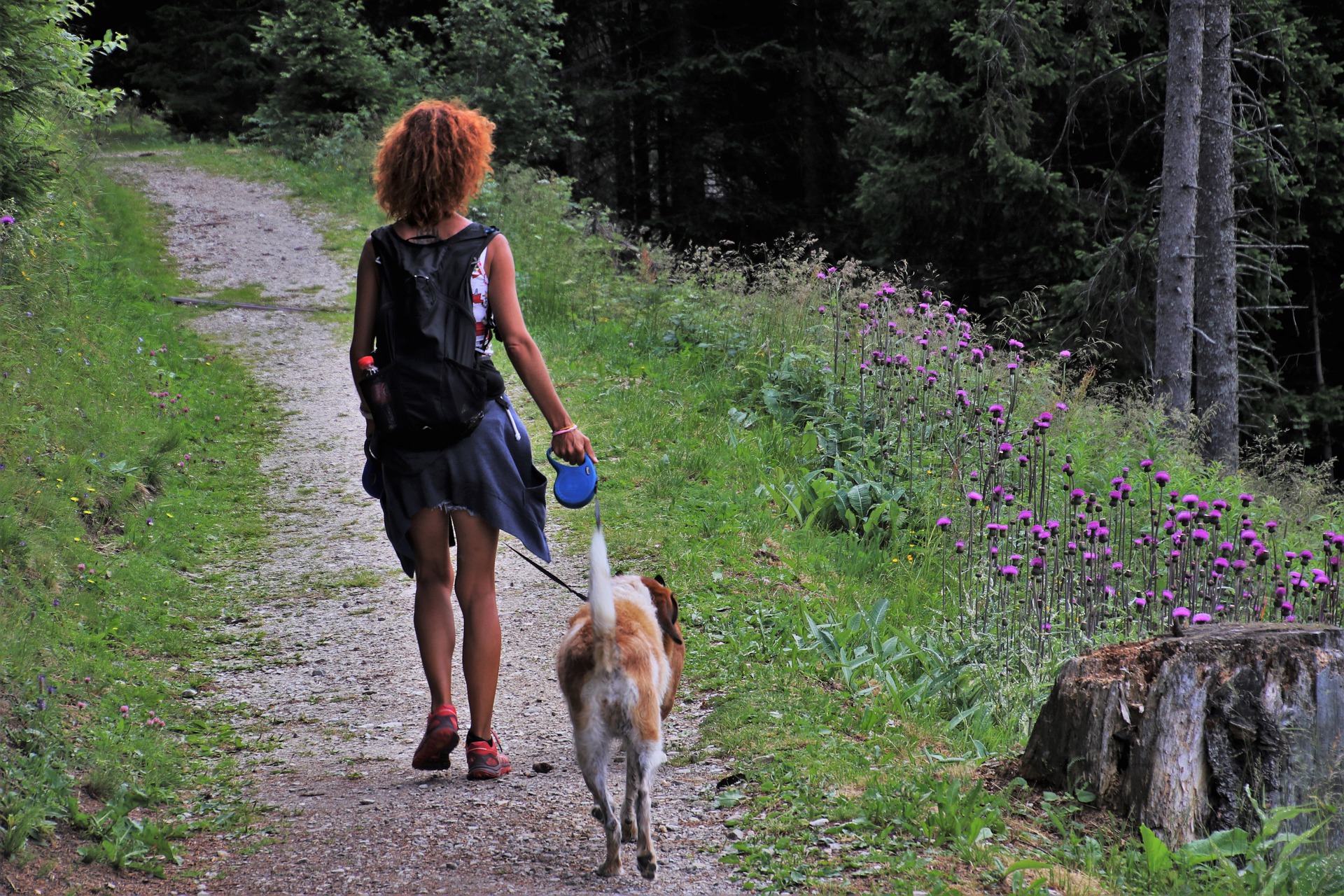
I am very fortunate to work with motivated pet lovers when I perform surgery on their pets. Yet I am always surprised when they make the 3 following mistakes.
1. Allowing their pet to gain weight
Allowing your pet to be overweight increases their chances of getting certain diseases: diabetes, heart disease, urinary issues, tumors, orthopedic problems (such as ACL tears) and arthritis, to name a few.
It gets worse: obesity decreases your pets’ quality of life and shortens their lifespan.
Studies showed that maintaining a healthy weight can extend dogs’ lives for 2 years! The same concept likely applies to cats.
2. Giving your pet “freedom”
Every year, I fix a number of broken bones that could have been totally avoided. If more dogs were on a leash and fewer cats were allowed to go outside in the name of “freedom”, there would be much fewer broken bones.
Dogs and cats will never win the battle against a moving vehicle. The damage can be extensive, even life-threatening. Not using a leash may also increase the risk of your pet getting into a fight with unfriendly four-legged neighbors or even wildlife.
Use a leash – save a life (and money).
3. No pet insurance
Surprisingly, pet insurance is still a fairly new concept for some pet owners. Pet insurance can help with unforeseen emergencies or surgeries.
Similar to health insurance for humans, it will help offset some of the cost of pet ownership. It may give you much needed assistance in the event of an emergency or costly but necessary surgery.
Now… not all pet insurance companies are created equal. Some are good, some are really bad… So do your research to find the company and plan that’s right for you and your pet.
On that note, I’ve heard many pet owners say “I’ve paid for pet insurance for years, and I never used it, so I stopped paying for it.”
Ironically, we typically have this discussion when they need my surgical services (Murphy’s Law)… ie when it’s too late!
With all due respect, this is not the right way to think about pet insurance. Would you ever say “I’ve paid for fire insurance for years, and I never used it, so I stopped paying for it. Man, I wish my house had burned down so I could make my investment work for me!”
Of course you’d never say that!
It’s the same for pet insurance.
It’s not an investment.
When you buy pet insurance, you are buying peace of mind.
You are buying the certainty that if and when your pet needs surgery or some other treatment, you will be able to help your pet without putting your personal financial situation at risk (one big caveat: as with any insurance, there are exclusions!).
So consider getting pet insurance, have peace of mind, and hope you never need it.
Phil Zeltzman, DVM, DACVS, CVJ, Fear Free Certified

Dr. Phil Zeltzman is a traveling veterinary surgeon in Pennsylvania & New Jersey. An award-winning author, he loves to share his adventures in practice along with information about vet medicine and surgery that can really help your pets. Dr. Zeltzman specializes in orthopedic, neurologic, cancer, and soft tissue surgeries for dogs, cats, and small exotics. By working with local family vets, he offers the best surgical care, safest anesthesia, and utmost pain management to all his patients. Sign up to get an email when he updates his blog, and follow him on Facebook, too!
Harper the Greyhound needs reconstructive surgery of… the lip
Harper, a 7 year old greyhound, had a fleshy mass the size of a silver dollar inside her right upper lip.
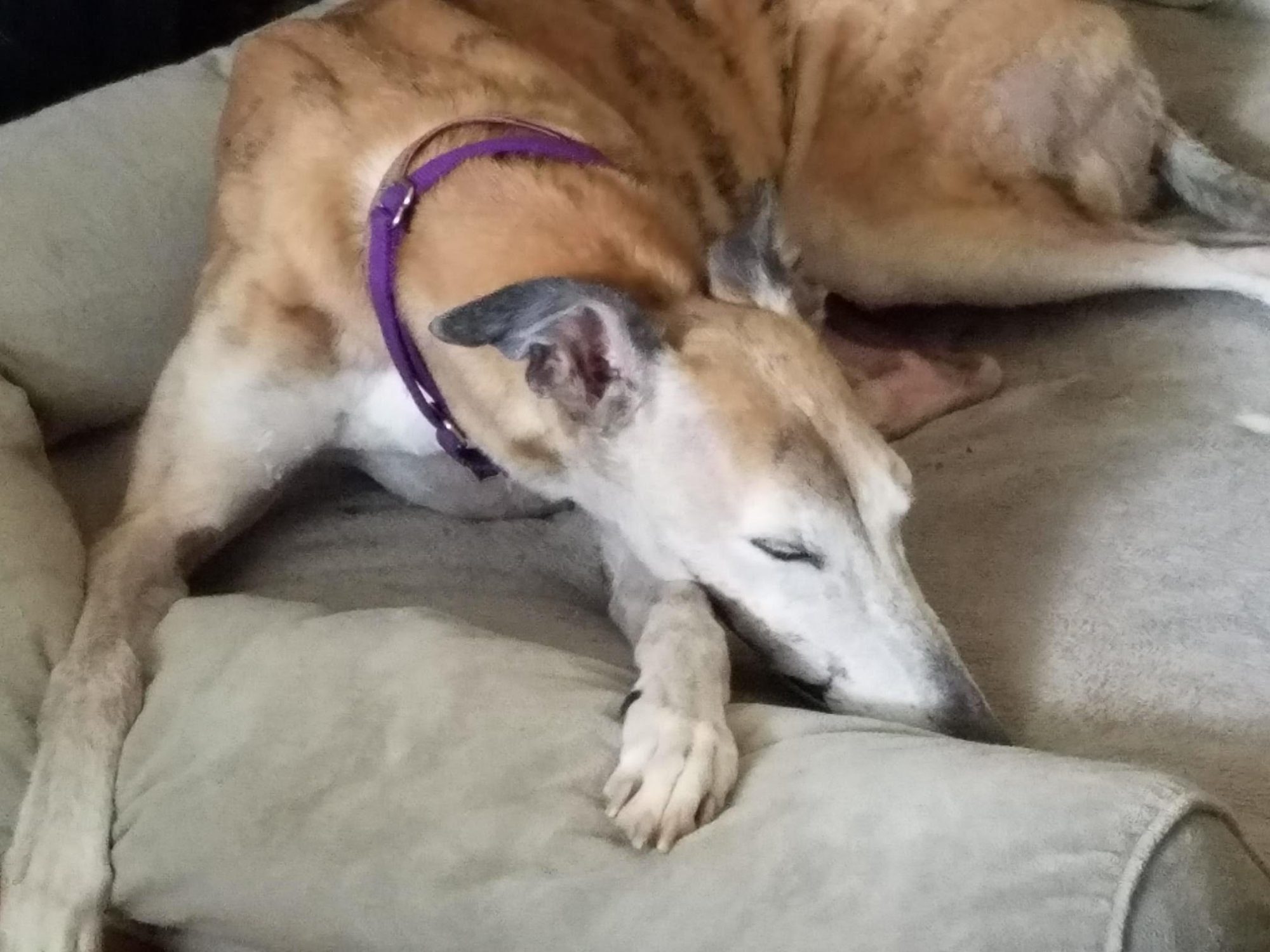
Her family vet did a “debulking” surgery to try and remove as much of the mass as possible without removing the lip itself. The tissue removed from Harper’s mouth was sent to the lab for biopsy. The biopsy revealed a mast cell tumor, which is unusual in the mouth.
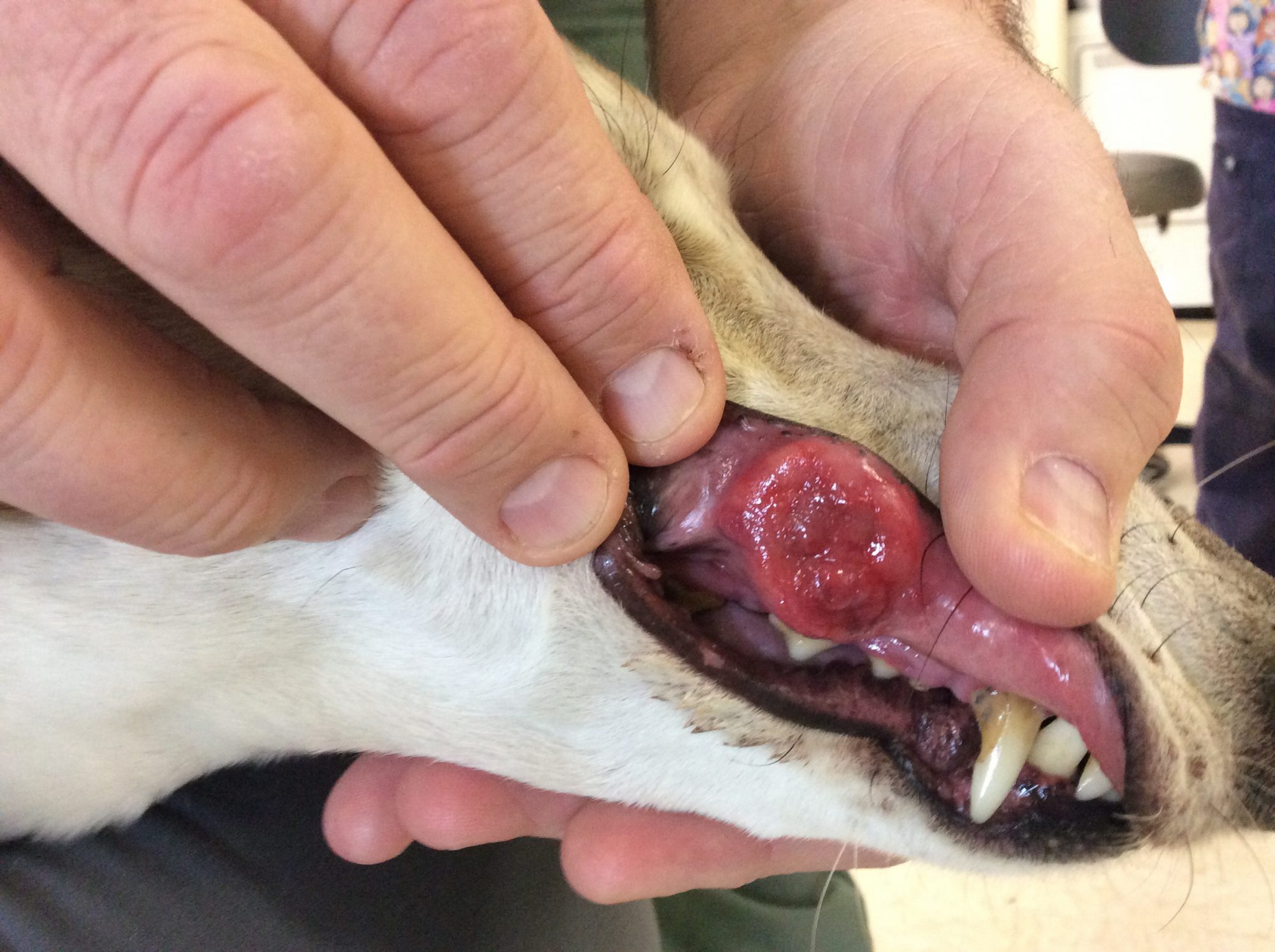
Mast cells are normal white blood cells we all have. They play a role in the body’s response to allergies and inflammation. Sometimes, they become cancerous, most commonly in the skin.
Occasionally, they can affect other body parts, such as the spleen, the liver or the intestine… or the mouth as in Harper’s case.
Complete removal of the mass is the ideal treatment. When we try to get “clean edges” in surgery, we call it getting “clean margins”.
More aggressive tumors or “dirty margins” (i.e. when the tumor was not completely removed) sometimes require additional treatment such as radiation or chemotherapy.
Unfortunately for Harper, due to the size and location of her mass, clear margins were not obtained with her first surgery. That’s when I was called in to perform a more invasive surgery, which would require reconstructive surgery.
To ensure clean margins were achieved this time around, I needed to remove a big chunk of Harper’s lip.
This left us with a hole I had to get creative to close.
I used what is called a skin flap. Using skin from the cheek, and by pulling it into the surgical area, I was able to reconstruct Harper’s upper lip (the pictures are a bit too graphic for this humble blog). There was some considerable pressure along the incision postop, which was a concern for healing. There was a chance the stitches would not hold up…
Harper recovered smoothly from anesthesia. She went home with instructions to keep her quiet and to prevent her from chewing on anything, including toys. The incision had to be protected at all time with a plastic cone (E collar).
About a week later, the biopsy was read as a mast cell tumor – no surprise there. The great news was that we were able to “get it all”, i.e. we had clean margins.
Three weeks later, Harper showed good healing, but I was concerned that the incision looked so crusty. Rather than aggravating the incision by removing the stitches and the scabs, we decided to leave the sutures in for an additional week.
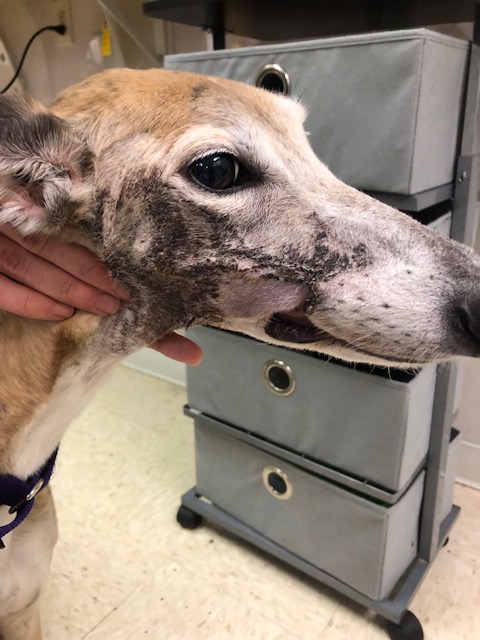
Harper was able to open and close her mouth without any issues, which was a huge relief. Her family vet was able to take a picture while she was yawning at the clinic!
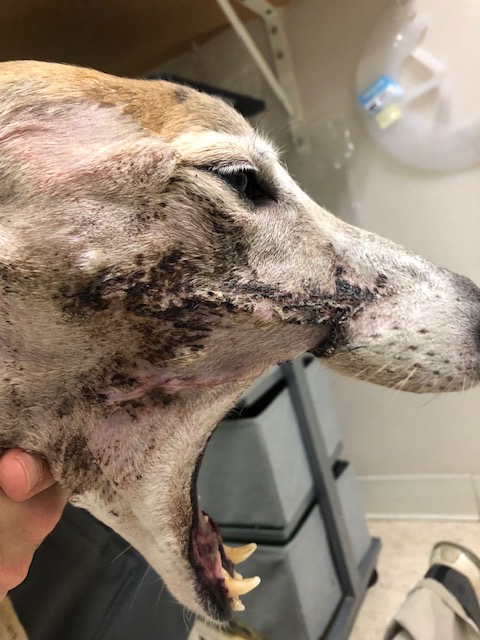
That showed us that Harper could fully open her mouth. It turn, it meant that she could play with chew toys and balls in the future.
One week later (1 month after surgery), the incision looked immensely better. The stitches were removed. And Harper could resume her normal activity.
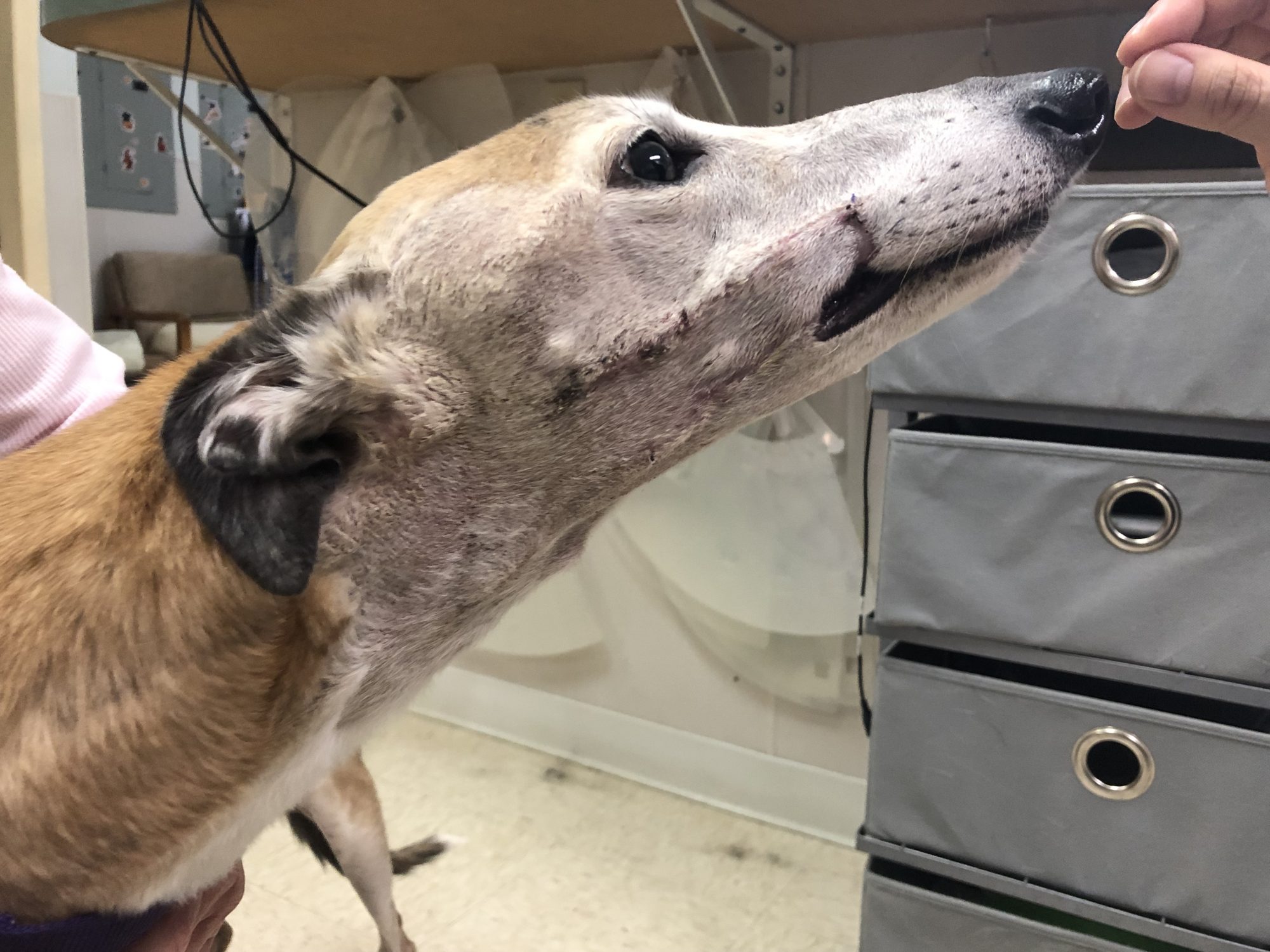
Harper’s mouth will be checked by her family vet during regular check-ups. She is still doing great 6 months after surgery.
Her owner GK wrote:
“Hello Dr. Zeltzman,
We wanted to share with you how happy we are with the outcome from Harper’s surgery.
She looks absolutely fantastic, with her scar only being approximately 1/2 inch long.
The healing process was a little rough in the beginning but with all the excellent instructions we were given we knew what to expect.
But overall it seemed to be a quick process and Harper is as good as new and back to her silly greyhound antics.
Thank you for taking such excellent care of our girl.”
Phil Zeltzman, DVM, DACVS, CVJ, Fear Free Certified

Dr. Phil Zeltzman is a traveling veterinary surgeon in Pennsylvania & New Jersey. An award-winning author, he loves to share his adventures in practice along with information about vet medicine and surgery that can really help your pets. Dr. Zeltzman specializes in orthopedic, neurologic, cancer, and soft tissue surgeries for dogs, cats, and small exotics. By working with local family vets, he offers the best surgical care, safest anesthesia, and utmost pain management to all his patients. Sign up to get an email when he updates his blog, and follow him on Facebook, too!
Why do we do what we do? (Part 2)
Have you ever wondered why vets and their nurses do what they do?
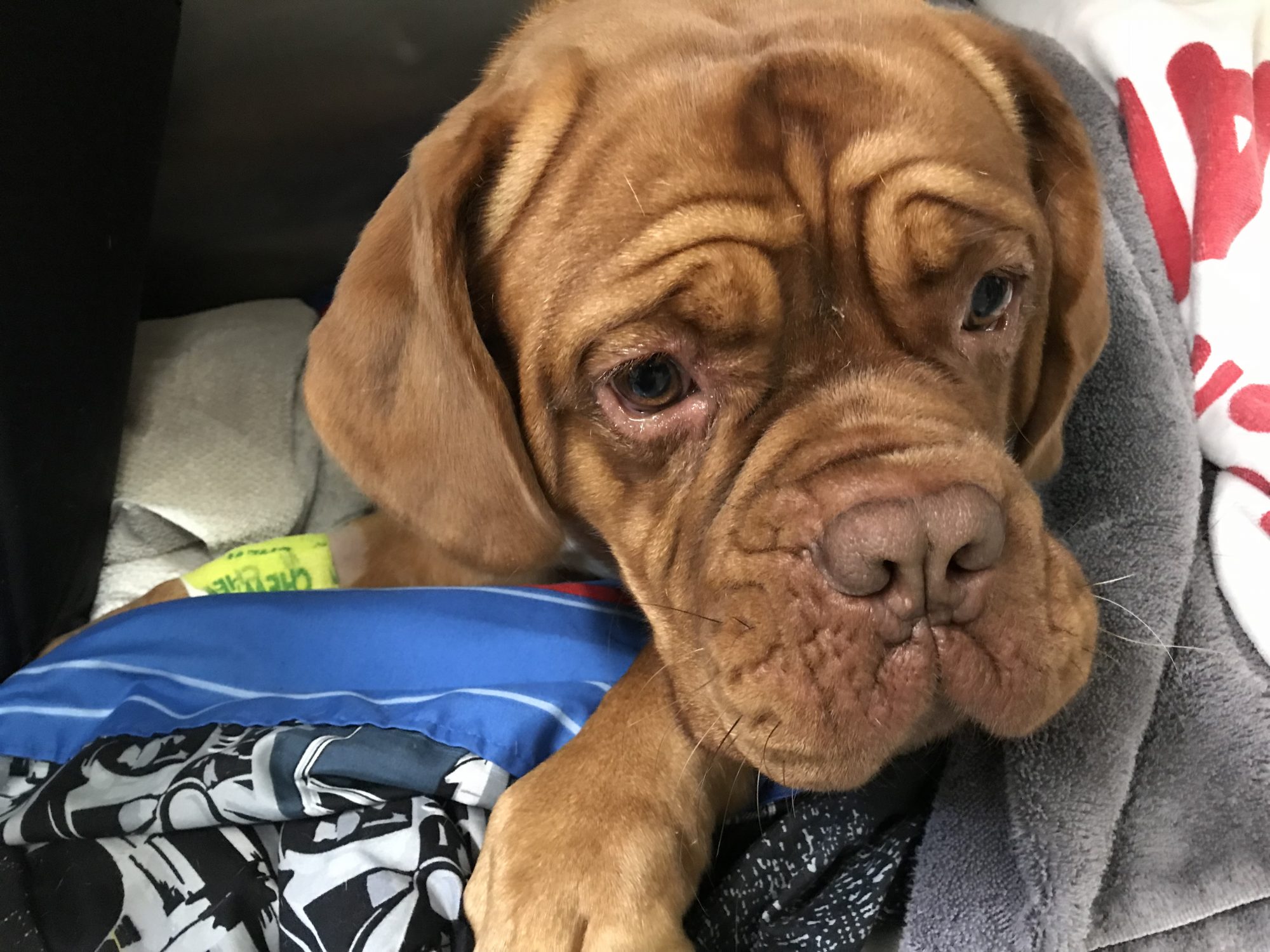
Ruby, a 2 year old Dogue de Bordeaux, wakes up from anesthesia after a TPLO to address a tear of her ACL
Last week, we described 5 things we do around surgery time, and why we do them
This week, we share 5 more features we provide routinely to your pet during anesthesia and surgery.
6. Why do we place a tube down the throat?
It’s not just down the throat, it’s into the windpipe, so that oxygen and anesthetic gas can be delivered to the lungs.
Interestingly, anesthetic gas is so powerful (yet safe) these days, that with the proper pain medications on board, we can often get by with only 1 or 2% anesthesia gas and 98 or 99% oxygen.
The tube allows us to have control of the patients breathing. So for example, we can breathe for the patient or “give a breath” if the patient doesn’t take enough oxygen in, or keeps too much CO2 in.
7. What do we monitor during anesthesia?
Monitoring a patient allows us to make anesthesia as safe as humanly possible. Depending on the sophistication of the hospital, we monitor multiple values, including:
. Temperature
. Heart rate
. EKG
. Blood pressure
. Oxygen level
. CO2 level
8. Why do we monitor anesthesia?
100% of the clinics I do surgery at have a dedicated anesthesia nurse, whose only job is to monitor the patient and make sure anesthesia is as safe as possible (if you read between the lines, this means that not all clinics take that precaution…).
Why does a nurse monitor a patient under anesthesia?
To make sure that the patient is sleeping soundly, and that the numbers on the anesthesia monitor are what they should be. Besides the monitor, nurses check on the patient. They check on the color of the gums, the depth of the anesthesia, the pulse, the breathing etc.
9. What’s the end result of monitoring?
Monitoring patients closely allows us to catch changes and correct them before they become a bigger problem.
* If you are not monitoring a patient’s blood pressure, how would you know that it is low and needs to be corrected?
* If the temperature is too low, we add even more devices that we had to begin with, in order to keep the patient warm.
* If you are not monitoring a patient’s EKG, how would you know that the heartbeat is abnormal and needs to be corrected?
In some cases, the nurse knows exactly what to do. In other cases, the doctor and the nurse come up with a plan to correct whatever needs to be corrected.
10. What happens once surgery is over?
Anesthesia stops after the patient is cleaned up and ideally has been on 100% oxygen for a while. Then the patient goes to the recovery area. There, the patient must still be monitored very closely.
Here is a little secret (too) few people know about: most pet owners are scared of anesthesia. In fact, most pets who die (thankfully extremely rarely), do so AFTER anesthesia is over. So this part is still critical and must be taken very seriously.
Similar to what is done during anesthesia, certain things are monitored during recovery: pulse, heart rate, gum color, temperature, as well as comfort level. Once the patient becomes conscious and won’t tolerate the breathing tube in their throat, the tube is removed.
Still, patients must be monitored until they are fully aware of their surroundings!
And then, nurses must still keep a close eye on their patients, on and off, until they feel confident that they are “out of the woods.”
In the end, these 5 steps are designed to make anesthesia and surgery safer for your pet. This is our ultimate goal.
Phil Zeltzman, DVM, DACVS, CVJ, Fear Free Certified

Dr. Phil Zeltzman is a traveling veterinary surgeon in Pennsylvania & New Jersey. An award-winning author, he loves to share his adventures in practice along with information about vet medicine and surgery that can really help your pets. Dr. Zeltzman specializes in orthopedic, neurologic, cancer, and soft tissue surgeries for dogs, cats, and small exotics. By working with local family vets, he offers the best surgical care, safest anesthesia, and utmost pain management to all his patients. Sign up to get an email when he updates his blog, and follow him on Facebook, too!
Why do we do what we do?
Have you ever wondered why vets and their nurses do what they do?
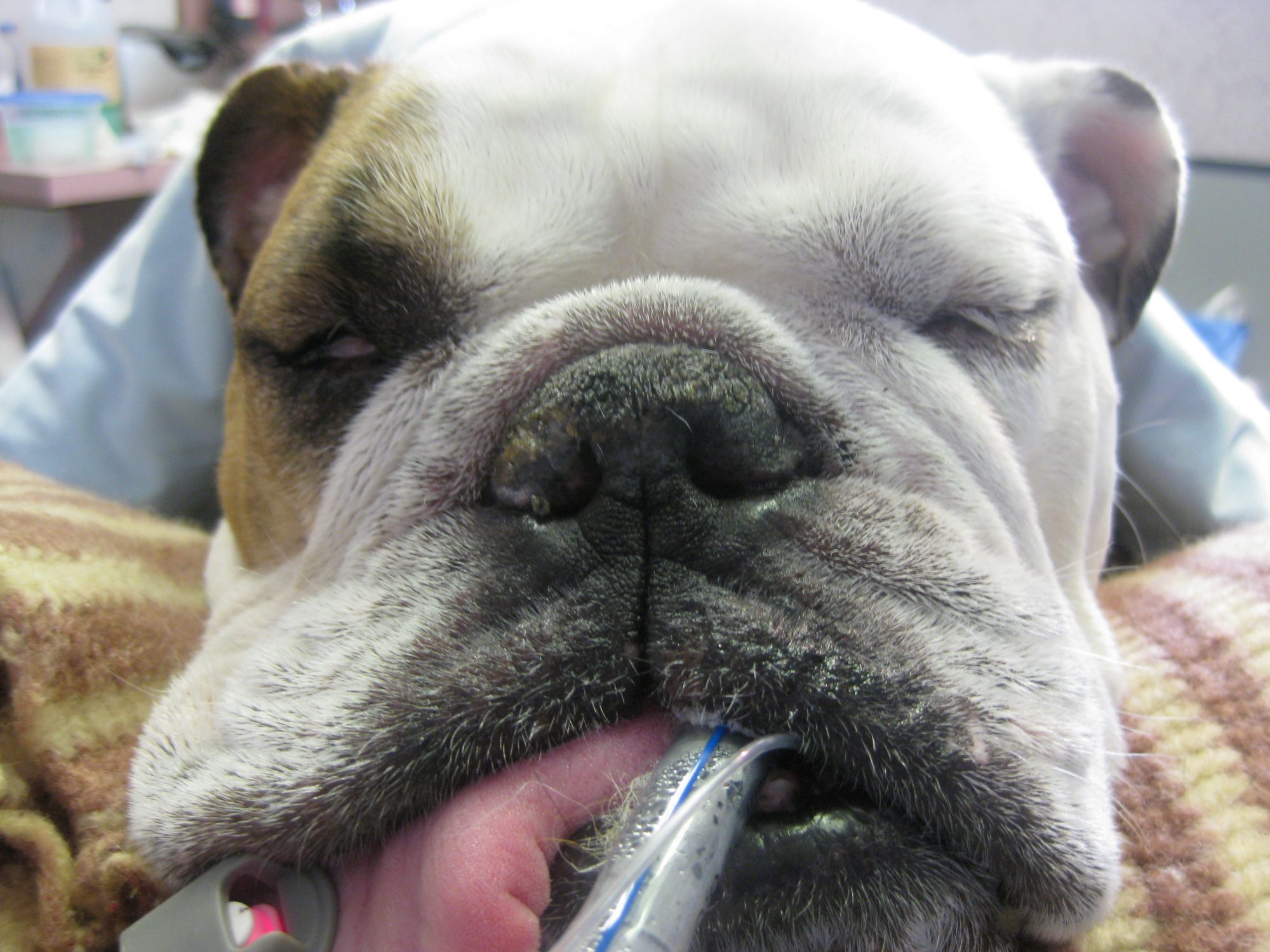
A Bulldog under anesthesia
Here are 5 common things we do around surgery time, and why we do them.
1. Why do we do blood work?
We perform preop blood work to make sure that the patient’s organs are healthy and functioning properly. We mostly look at the immune system, the red blood cells, the clotting system, the liver and the kidneys.
If one of these organs doesn’t work properly, it can dramatically affect the safety of anesthesia or surgery. In some cases, we may need to treat or “stabilize” the patient before we even consider surgery.
Many drugs are processed by the liver and the kidneys, so if they are not working well, the drugs will stay in the patient’s system for much longer than normal and could lead to complications such as a delayed recovery.
2. Why do we place an IV catheter?
We place an IV catheter for several reasons:
* To “stabilize” a patient before surgery, for example to correct abnormal electrolytes.
* To give a tranquilizer, before or after surgery.
* To give IV pain medications.
* To give IV antibiotics.
* To give IV fluids.
* To give IV emergency drugs if needed.
3. Why do we give IV fluids?
We give IV fluids for several reasons:
* To correct abnormal electrolytes (to increase or decrease them).
* To dilute some IV drugs.
* To make sure the patient is well hydrated.
* To make sure the blood pressure is high enough.
* To make sure we have easy access to a vein in case we need to give emergency drugs.
4. Why do we give IV antibiotics?
Under anesthesia, the patient’s immune system is weakened. Since neither the skin nor the air nor the environment is completely sterile, bacteria always end up in the surgical site. To prevent an infection, we give antibiotics before, during and after surgery.
Some organs are riskier than others: there are more, and more dangerous, bacteria in the intestine (think about removing a rock or a tennis ball from the intestine), than on the skin (think about removing a skin tumor).
5. Why do we give IV pain medications?
We give pain meds before anesthesia because it sedates or relaxes the patient. Interactions and minor procedures (e.g. placing an IV catheter or taking X-rays) are therefore less stressful.
In addition, it is better to give pain meds before the surgery starts because a smaller amount is needed. If we waited until the patient has been “stimulated” during surgery, we would need a bigger dose.
Ultimately, these 5 steps are designed to make anesthesia and surgery safer for your pet. This is our primary goal.
Phil Zeltzman, DVM, DACVS, CVJ, Fear Free Certified

Dr. Phil Zeltzman is a traveling veterinary surgeon in Pennsylvania & New Jersey. An award-winning author, he loves to share his adventures in practice along with information about vet medicine and surgery that can really help your pets. Dr. Zeltzman specializes in orthopedic, neurologic, cancer, and soft tissue surgeries for dogs, cats, and small exotics. By working with local family vets, he offers the best surgical care, safest anesthesia, and utmost pain management to all his patients. Sign up to get an email when he updates his blog, and follow him on Facebook, too!

